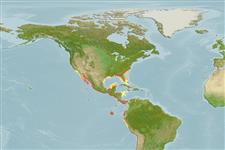>
Eupercaria/misc (Various families in series Eupercaria) >
Gerreidae (Mojarras)
Etymology: Eucinostomus: Greek, eu = good + Greek, kyon = dog + Greek, stoma = mouth (Ref. 45335).
More on author: Gill.
Environment: milieu / climate zone / depth range / distribution range
Écologie
marin; eau douce; saumâtre démersal; profondeur 1 - 50 m. Subtropical; 35°N - 12°S, 120°W - 75°W
Eastern Pacific: Anaheim Bay, southern California, USA to Peru.
Taille / Poids / Âge
Maturity: Lm ? range ? - ? cm
Max length : 21.0 cm TL mâle / non sexé; (Ref. 2850); common length : 12.0 cm TL mâle / non sexé; (Ref. 55763)
Body fusiform, compressed, and slender (depth contained 3.2 to 3.6 times in standard length); jaws protrusible; edge of preopercle smooth; second anal spine short and thin; pelvic fin short (1.8 to 2.0 times in head length); body silvery, darker in the dorsal region; fins transparent except for tips of dorsal spines which are black (Ref. 55763).
Found over soft bottoms of coastal waters, especially abundant in brackish waters (Ref. 9303). Feeds on crabs and shrimps (Ref. 37955). Depth range assumed (RF).
Life cycle and mating behavior
Maturité | Reproduction | Frai | Œufs | Fécondité | Larves
Eschmeyer, W.N., E.S. Herald and H. Hammann, 1983. A field guide to Pacific coast fishes of North America. Boston (MA, USA): Houghton Mifflin Company. xii+336 p. (Ref. 2850)
Statut dans la liste rouge de l'IUCN (Ref. 130435)
Menace pour l'homme
Harmless
Utilisations par l'homme
Pêcheries: intérêt commercial mineur; appât: occasionally
Plus d'informations
Noms communsSynonymesMétabolismePrédateursÉcotoxicologieReproductionMaturitéFraiRassemblement de ponteFéconditéŒufsDéveloppement de l'œuf
RéférencesAquacultureProfil d'aquacultureSouchesGénétiqueElectrophoresesHéritabilitéPathologiesTraitementNutrientsMass conversion
CollaborateursImagesStamps, Coins Misc.SonsCiguateraVitesseType de nageSurface branchialeOtolithesCerveauxVision
Outils
Articles particuliers
Télécharger en XML
Sources Internet
Estimates based on models
Preferred temperature (Ref.
123201): 22.3 - 28.1, mean 24.2 °C (based on 274 cells).
Phylogenetic diversity index (Ref.
82804): PD
50 = 0.5010 [Uniqueness, from 0.5 = low to 2.0 = high].
Bayesian length-weight: a=0.01096 (0.00850 - 0.01415), b=3.10 (3.06 - 3.14), in cm total length, based on LWR estimates for this species (Ref.
93245).
Niveau trophique (Ref.
69278): 3.1 ±0.3 se; based on diet studies.
Résilience (Ref.
120179): Haut, temps minimum de doublement de population inférieur à 15 mois (Preliminary K or Fecundity.).
Fishing Vulnerability (Ref.
59153): Low vulnerability (11 of 100).
Nutrients (Ref.
124155): Calcium = 150 [77, 307] mg/100g; Iron = 1.27 [0.65, 2.39] mg/100g; Protein = 19.3 [17.4, 21.1] %; Omega3 = 0.401 [0.220, 0.723] g/100g; Selenium = 20.8 [10.9, 39.4] μg/100g; VitaminA = 11.9 [3.7, 33.5] μg/100g; Zinc = 1.17 [0.80, 1.67] mg/100g (wet weight);
